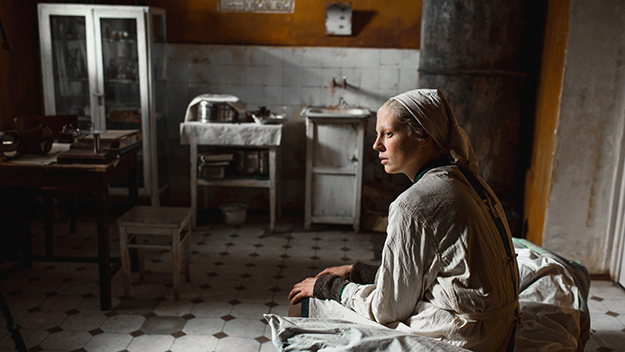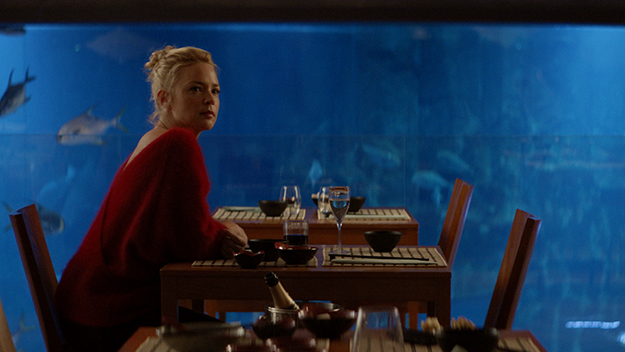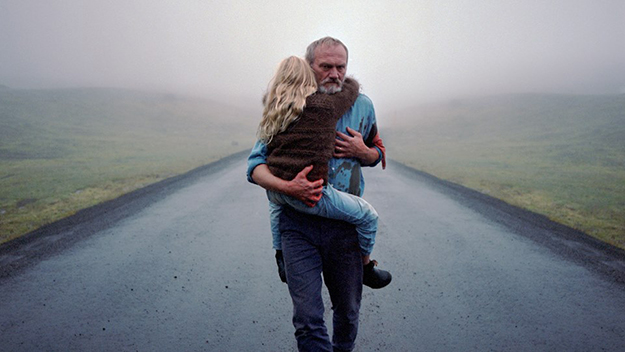Beanpole (Kantemir Balagov, 2019) Of all the major film festivals, Cannes arguably offers the least in terms of discoveries of completely new or unknown talent. This is partly due to their dedication to established names, partly to the fact that the Critics’ Week sidebar—focused on first- and second-time filmmakers—tends to take more risks on adventurous visions from young directors than does the main selection committee, and partly to the curious choices they do make when elevating new names into the spotlight. There are exceptions, of course, and as a result they tend to stick out. In 2016, Kantemir Balagov came more or less out of nowhere with his FIPRESCI prize-winning debut Closeness, which premiered in the festival’s Un Certain Regard section. A protégé of Russian giant Aleksandr Sokurov, the 27-year-old Balagov returns to Un Certain Regard in 2019 with Beanpole, his second feature. Though hesitant to describe his work (“Freedom from meaning allows you to create your own meaning,” he tells Film Comment), Balagov has clearly upped his ambition with his latest, a post–World War II drama inspired by Svetlana Alexievich’s book The Unwomanly Face of War about two women rebuilding their lives in the wake of the Siege of Leningrad. For his part, the director is taking the selection (and the increased attention that comes with it) in stride: “The film is [already] starting to live its own life.” Rising filmmakers at Cannes generally cut their teeth at other festivals or in one of the parallel sections before graduating to the Competition. Two of this year’s most enticing prospects who followed this trajectory are China’s Diao Yi’nan and France’s Justine Triet. Winner of the Golden Bear at the 2014 Berlinale for Black Coal, Thin Ice, Diao returns to the crime genre with The Wild Goose Lake, the tale of a gangster and a prostitute who meet in South China while attempting to outrun their pasts. Triet, meanwhile, arrives after bringing her two previous features, Age of Panic (2013) and In Bed with Victoria (2016), to the ACID and Critics’ Week programs, respectively. Her latest, Sibyl, follows the title character (Virginie Efira), a psychotherapist and moonlighting author, who, in an attempt to draw writing inspiration from real life, becomes increasingly obsessed with her new patient, an actress (Adèle Exarchopoulos). According to Triet, the two women quickly develop a “murky, co-dependent bond,” plunging Efira’s character, who the director modeled after real life therapists, into “a dizzying abyss.” Shot partially in Stromboli and inspired, per Triet, by both Woody Allen’s Another Woman and the HBO drama In Treatment, Sibyl promises to bring a newly cerebral, existential dimension to Triet’s work.
Sibyl (Justine Triet, 2019) Four women in total are competing for this year’s Palme d’Or. Along with Triet, there’s French actress and filmmaker Mati Diop with her first feature Atlantics, an allegorical fiction about two young lovers whose romance is threatened by a volatile collision of cultural and ecological forces; Girlhood director Céline Sciamma with Portrait of a Lady on Fire, an 18th-century romantic tragedy starring Noémie Merlant and Adèle Haenel as an emotionally entwined young painter and bride-to-be, respectively; and Austrian director Jessica Hausner with Little Joe, one of the festival’s most mysterious and intriguing titles. Starring Emily Beecham as a scientist and single mother who genetically engineers a potentially dangerous new plant breed, Hausner’s first English-language film (following a quartet of beautifully austere features, including 2014’s magisterial Amour fou) is, as the director tells Film Comment, a kind of spin on the Frankenstein story, “with a female Frankenstein in the lead role.” At the same time, the character is struggling to balance her professional and maternal responsibilities: “She has feelings of guilt because she thinks she cannot do both well,” the filmmaker says. But despite the story’s vaguely dystopian, science-fiction sensibility, Hausner suggests a happy ending is in store: “Frankenstein finally hugs her monster.” Other young directors of note this year at Cannes include the Afghan filmmaker Shahrbanoo Sadat, back in Directors’ Fortnight with the 1980s-set social parable The Orphanage, three years after bringing Wolf and Sheep to the same section in 2016; Chinese-Canadian director Johnny Ma, whose musical-drama To Live to Sing (also playing in the Fortnight) follows a woman working to revive the fortunes of her struggling theater troupe; French-born Galician filmmaker Oliver Laxe, following up his Critics’ Week prizewinner Mimosas with the Un Certain Regard entry Fire Will Come, a sure-to-be visually striking drama (shot, like Mimosas, by the great cinematographer and filmmaker Mauro Herce), centered on a convicted arsonist who decamps to his home village in the Galician mountains upon release from prison; and, in Critics’ Week, Iceland’s Hlynur Pálmason with his second feature A White, White Day. The film, which Pálmason describes to Film Comment as “a diatribe or a hate poem to the dead,” tells of a widowed police chief who begins to suspect a local man of having had an affair with his late wife. Shooting over a two-year period on the east coast of Iceland, near his hometown, Pálmason was keen to capture the region’s volatile climate while reflecting on two distinct forms of love, the unconditional familial kind and the romantic, “intimate, animal” one. The filmmaker went on, more cryptically: “But perhaps the trigger was this white day: there is a saying in Iceland that when everything is white and there is no longer any difference between the earth and the sky, then the dead can talk to us that are still living.”
A White, White Day (Hlynur Pálmason, 2019) Another first-time Cannes participant, Beatrice Gibson, says “it feels surreal” to be bringing her film to the festival. The Franco-British artist, whose new short Two Sisters Who Are Not Sisters will bow in Directors’ Fortnight, is known largely in experimental cinema and art circles for her highly personal and poetic moving-image work, including last year’s politically incisive I Hope I’m Loud When I’m Dead. Her latest, based on a 1948 play by Gertrude Stein, plays with doubles and genre conventions. “It’s an abstract thriller,” Gibson says. “A crime thriller without a crime. A crime poem if you like. It features two sisters (who are not sisters), two pregnancies, a two-seater car, two poodles (one real one photographic), a beauty queen, and a fascist, and unfolds with the logic of a dream. It’s also fundamentally a portrait of the people in it, as well as a meditation on inheritance, responsibility, ethics and futurity.” And those people in Two Sisters Who Are Not Sisters aren’t just anyone. From across the art and film worlds, the featured players include New York School poet Alice Notley and experimental filmmakers Ana Vaz and Basma Alsharif; Gibson’s prior collaborator, Ben Rivers, shoots the movie on 16mm anamorphic film. (It will screen at Cannes on 35mm.) Two Sisters… joins a growing number of gestures on the part of Cannes’ parallel sections toward more experimental cinema. See also Gabriel Abrantes’ The Marvelous Misadventures of the Stone Lady in Directors’ Fortnight and, in Critics’ Week, Demonic by Pia Borg. “[It’s] extremely exciting because its means that there’s a place in Cannes for a different kind of cinema,” Gibson says. “Directors’ Fortnight was originally conceived to be that place, so it’s exciting to me that it’s returning to its roots in a way. The 1969 lineup was pretty experimental! I feel extremely honored to be connected to that.” Jordan Cronk is a critic and programmer based in Los Angeles. He runs Acropolis Cinema, a screening series for experimental and undistributed films, and is co-director of the Locarno in Los Angeles film festival.


